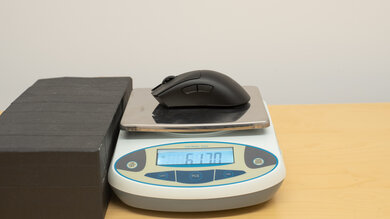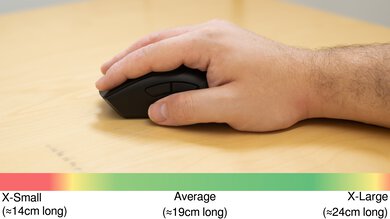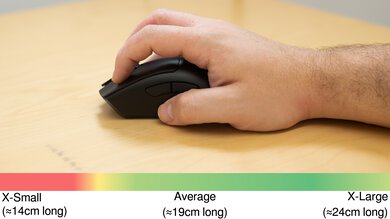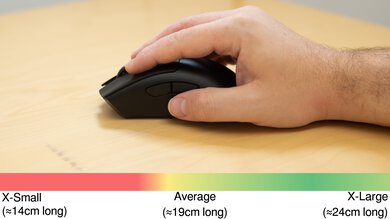The Razer DeathAdder V3 Pro is a lightweight, wireless gaming mouse that continues Razer's DeathAdder lineup. Like earlier versions, this mouse has a right-handed design and is best suited for larger-sized hands. As a departure from previous models, this version has a slightly different shape and is significantly more lightweight. It also includes several significant upgrades under the hood, including a new sensor, a new generation of optical switches, and improved battery life.
Our Verdict
The Razer DeathAdder V3 Pro is good for office and multimedia tasks, though it isn't specifically for this use. It connects wirelessly with its USB receiver, and you can reprogram all the buttons using the customization software. However, there's no Bluetooth connectivity, and the scroll wheel lacks a free-scrolling mode and left-right tilt inputs.
- Comfortable right-handed shape.
- Excellent build quality.
- Only suitable for larger-sized hands.
- Scroll wheel lacks left-right inputs and a free-scrolling mode.
- Bulky; isn't designed to be stored in laptop bags or cases.
The Razer DeathAdder V3 Pro is a remarkable FPS gaming mouse. It's extremely lightweight and feels very well built. The ergonomic, right-handed shape is comfortable, though it's best suited for larger-sized hands. The feet glide smoothly on mousepads and desks, the sensor is extremely accurate and consistent, and it has exceptionally low click latency.
- Extremely lightweight.
- Incredibly low click latency.
- Excellent build quality.
- Only suitable for larger-sized hands.
- Bulky; isn't designed to be stored in laptop bags or cases.
The Razer DeathAdder V3 Pro is a great mouse for MMO or MOBA gaming, though it doesn't have as many programmable buttons as a dedicated MMO gaming model. That said, this mouse feels very sturdy and comfortable for right-handed users with larger-sized hands. Performance-wise, it has incredibly low click latency and an extremely accurate and consistent sensor.
- Incredibly low click latency.
- Comfortable right-handed shape.
- Excellent build quality.
- Only suitable for larger-sized hands.
- Bulky; isn't designed to be stored in laptop bags or cases.
- Bulky; isn't designed to be stored in laptop bags or cases.
Changelog
- Updated Aug 19, 2025: We've converted this review to Test Bench 1.5.1. This update removes less relevant or redundant elements, including several videos. We've also adjusted our Sensor Latency testing, resulting in minor score changes. See our full 1.5.1 changelog for details.
-
Updated May 30, 2025:
We've updated this review to reflect that the latest version of Razer Synapse, this mouse's companion software, is now supported on macOS devices with Apple Silicon.
-
Updated Feb 27, 2025:
We've added a link to the newly reviewed Pulsar X3 in the Hand Size Recommendation section.
-
Updated Nov 11, 2024:
We've added a link to the newly reviewed Logitech G PRO X SUPERLIGHT 2 DEX in the Hand Size Recommendation section.
Check Price
Differences Between Sizes And Variants
The Razer DeathAdder V3 Pro we tested is the black colorway. There is also a white color variant available. You can see the label for our unit here.
Popular Mouse Comparisons
The Razer DeathAdder V3 Pro continues Razer's popular DeathAdder lineup. This mouse features several improvements over the Razer DeathAdder V2 Pro, including an updated sensor, the newest generation of Razer's optical switches, and a longer advertised battery life. This version is also significantly lighter. However, it's important to note that Razer has made changes to the shape of this version, and it feels noticeably different in hand than earlier DeathAdder models. This mouse has outstanding gaming performance, similar to Razer's other premium-priced flagship, the Razer Viper V2 Pro. The main difference between this mouse and the Viper V2 Pro is that this mouse has a right-handed shape best suited for larger-sized hands and a palm or claw grip. In contrast, the Viper V2 Pro has a symmetrical shape best suited for a broader range of hand sizes and a claw or fingertip grip.
For other recommendations, see our picks for the best wireless gaming mice, the best FPS mice, and the best lightweight mouse.
The Razer DeathAdder V3 Pro and the Logitech G PRO X SUPERLIGHT are high-end wireless gaming mice. They are both extremely lightweight, weigh virtually the same, and offer similarly outstanding gaming performance. The biggest difference between them is their shape. The Razer has a right-handed design best suited for larger hands using a palm or claw grip. On the other hand, the Logitech has a symmetrical shape and is suitable for a wider range of hand sizes and grip types. The Razer also has a slightly longer advertised battery life and uses optical left- and right-mouse buttons, while the Logitech has mechanical switches.
The Razer DeathAdder V3 Pro and Razer DeathAdder V3 are very similar mice in the same lineup. The V3 Pro is a wireless model and is marginally heavier. On the other hand, the V3 is a wired-only model that has a smoother matte plastic finish and supports a higher maximum polling rate of 8000Hz.
The Razer Viper V3 HyperSpeed and the Razer DeathAdder V3 Pro are both high-end wireless gaming mice. The DeathAdder has an ergonomic right-handed shape and uses an internal rechargeable battery. It's also significantly lighter than the Viper. On the other hand, the Viper uses an AA battery for power and has slightly better build quality than the DeathAdder.
The Razer DeathAdder V3 Pro and the Razer Viper V2 Pro are high-end wireless gaming mice. They both weigh virtually the same and have very similar outstanding gaming performance; the major difference between them is shape. The DeathAdder has a right-handed shape and is best suited for larger hands using a palm or claw grip. On the other hand, the Viper V2 Pro has a symmetrical shape and is best suited for a somewhat wider range of hand sizes using a claw or fingertip grip.
Test Results

The Razer DeathAdder V3 Pro looks very similar to previous versions in the lineup, but Razer has made several small changes to the shape and removed the RGB lighting and pair of CPI buttons below the scroll wheel. This version also has distinct left- and right-click buttons, while on previous versions, they were part of the outer body.
If you're looking for a gaming mouse with RGB lighting, check out the ASUS ROG Keris II Ace.
The Razer DeathAdder V3 Pro feels very sturdy, despite being significantly lighter than previous versions. There aren't any rattling sounds if you shake the mouse, and the click buttons are very stable. That said, the bottom panel exhibits some flex with enough pressure, and you can actuate the side buttons if you squeeze with enough force into the plastic sides of the mouse. However, neither of these minor issues should present problems during regular use.
The Razer DeathAdder V3 Pro is extremely lightweight and significantly lighter than the previous generation DeathAdder V2 Pro. It's also only marginally heavier than the smaller Razer Viper V2 Pro.
Note: Razer indicates the white-colored variant of this mouse is approximately one gram heavier than the black version due to differences in the painting process.
If you're looking for a mouse with a similar shape that weighs even less, check out the Pulsar Xlite V3.
The Razer DeathAdder V3 Pro has a comfortable, right-handed shape with a fairly tall profile, making it well-suited for a palm or claw grip. Razer has made some small modifications to the shape of this version, so it does feel quite different in hand compared to previous DeathAdders. This version has more subdued flared edges towards the front and has more shallow comfort grooves on both the left- and right-click buttons. The hump on the palm rest has also been moved slightly towards the inside edge, and the side buttons are a bit higher on the body.
If you're looking for a similar right-handed option that's better suited for smaller hands, check out the Razer DeathAdder V3 HyperSpeed, The Logitech G PRO X SUPERLIGHT 2 DEX, or the LAMZU THORN.
If you're interested in another mouse with a right-handed shape but with a broader rear end that's more supportive for palm or claw hybrid grips, check out the review for Pulsar X3.
Alternatively, for a right-handed mouse with a smaller rearward hump, narrower middle, and a comparatively flatter profile, check out the Vaxee ZYGEN NP-01S Wireless (4K).
The Razer DeathAdder V3 Pro has an advertised battery life of up to 90 hours of constant motion using a 1000Hz polling rate. Razer also offers a "HyperPolling" receiver that you can buy separately, increasing the maximum polling rate to 8000Hz. Razer advertises a battery life of up to 17 hours at 8000Hz. Check out the ROG Harpe Ace Aim Lab Edition for a high-performance wireless gaming mouse with Bluetooth support.
The Razer DeathAdder V3 Pro has a lightweight and flexible cable that doesn't retain any kinks from its packaging.
The Razer DeathAdder V3 Pro has outstanding mouse feet with rounded edges. They glide easily on hard and soft mousepads and directly on desks, but they don't glide quite as smoothly as the feet on the Razer Viper V2 pro.
You can reprogram nearly all of the buttons on the Razer DeathAdder V3 Pro, except for the button on the underside of the mouse which is used to power the mouse on and off and cycle between five CPI settings. Additionally, one button needs to be set as the primary click button at all times. You can also set a Hypershift button which lets you program a secondary set of inputs. The left- and right-click buttons use Razer's Gen-3 optical switches and are rated for 90 million clicks.
The Razer DeathAdder V3 Pro has exceptionally low and very consistent click latency. It delivers an extremely responsive-feeling experience for gaming in any genre and is well-suited for casual or competitive play.
We also tested this mouse at 8000Hz using Razer's HyperPolling Dongle, which they sell separately. We found the click latency to be even better at an outstanding 1.3ms. Here is the graph of our results and here is the video.
The Razer DeathAdder V3 Pro has excellent sensor latency performance. It reacts to your inputs quickly, and you won't notice a delay. We conducted this test at the maximum native polling rate of 1000Hz.
We also tested this mouse at 8000Hz using Razer's HyperPolling Dongle, which they sell separately. We found that the sensor latency was better overall, with the delay to start of movement being 12.5ms, delay at half movement being 2.6ms and the delay to end of movement being 5.5ms. We were expecting the delay to end of movement to be better, so we reran the test multiple times to confirm and still got the same results. Here is a screenshot of our results, and here is the video.
The Razer DeathAdder V3 Pro's polling rate settings are 125Hz, 500Hz, and 1000Hz. Razer also offers a separate "HyperPolling" receiver available as a separate purchase on their website. This additional receiver allows you to increase the polling rate up to 8000Hz.
If you're interested in a similar wireless gaming mouse with a maximum polling rate of 8000Hz out of the box, check out the Logitech G PRO X SUPERLIGHT 2.
Overall, Razer's Synapse 3 software is very good. It's well laid out and fairly easy to use. You can customize various options, including CPI, lift-off distance, surface calibration, and power settings. However, similar to the software options from other major manufacturers, this software is the source of criticism from the broader community. While there weren't any issues experienced during the testing of this mouse, many users online criticize this software for requiring frequent updates and taking up disproportionate system resources, among other complaints. You may find this software frustrating if you prefer more lightweight software options or no software at all. If you're interested in a wireless gaming mouse with a very similar shape that doesn't have customization software but instead lets you adjust settings on the mouse itself, check out the BenQ ZOWIE EC2-CW or, for an option with a symmetrical shape, the Vaxee XE Wireless.
Only the new version of this software, Razer Synapse 4, is available for macOS.












